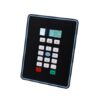Fiber optic backlighting employs thin strands of glass or plastic fibers that act as light guides. Light is introduced at one end of the fiber optic cable, typically from an LED source. This light travels through the core of the fiber due to a phenomenon called internal reflection, bouncing off the inner walls and minimizing light loss. The light exits the other end of the fiber, illuminating the target area.
Advantages of Fiber Optic Backlighting:
- Remote Light Source: The light source can be positioned away from the illuminated area, reducing heat generation and improving design flexibility.
- Uniform Illumination: Fiber optics distribute light evenly, eliminating glare and hotspots, creating a visually pleasing and comfortable viewing experience.
- High Light Efficiency: Due to minimal light loss within the fibers, fiber optic backlighting offers efficient light transmission.
- Durability: Fiber optic cables are highly durable and resistant to vibration, shock, extreme temperatures,energy saving,and no fever.
- Design Flexibility: Thin and flexible fibers can be easily shaped and customized to fit various lighting requirements.
- Cool Operation: Fiber optic cables themselves do not generate heat, contributing to a cooler operating environment.
Applications of Fiber Optic Backlighting:
- LCD Displays: Fiber optic backlights can enhance the uniformity and brightness of LCD displays in TVs, laptops, and other electronic devices.
- Signage and Displays: They are used in illuminated signs, architectural lighting, and point-of-sale displays for a visually striking effect.
- Medical Equipment: Fiber optic backlighting provides controlled and focused illumination in medical examination and diagnostic equipment.
- Machine Vision Systems: The uniform light distribution makes it ideal for machine vision applications, where precise object inspection is required.
- Edge Lighting: Fiber optics can create sharp and well-defined edge lighting effects for decorative and architectural applications.
- Specialty Lighting: Fiber optic backlighting is employed in a variety of specialized applications, including underwater lighting and instrument illumination.










